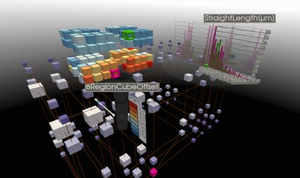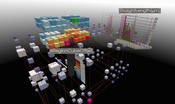Information
- Publication Type: Master Thesis
- Workgroup(s)/Project(s):
- Date: November 2020
- Date (Start): 15. January 2020
- Date (End): 24. November 2020
- TU Wien Library:
- Second Supervisor: Christoph Heinzl
- Diploma Examination: 24. November 2020
- Open Access: yes
- First Supervisor: Eduard Gröller

Abstract
Understanding and interpreting volumetric multidimensional data is a complex and cognitively demanding task. Especially in the field of material science the exploration of large spatial data is crucial. Non-destructive testing (NDT) plays an essential role in industrial production, especially in the field of material and component testing, regarding the analysis, visualization, and optimization of new, highly complex material systems such as fiber composites. In order to support the increasing demands on these materials and components of the future in industrial applications, extensive inspections and controls are essential. NDT inspection data generated by imaging techniques such as X-ray computed tomography (XCT) include 2D images, volumetric models, and derived high-dimensional data spaces. They can rarely, or only to a limited extent, be evaluated on desktop monitors using standard 2D visualization techniques. Therefore, novel immersive visualization and interaction techniques using Virtual Reality (VR) were developed in this thesis to investigate highly complex, heterogeneous material systems. We present a novel technique called "Model in Miniature" for an effective and interactive exploration and visual analysis of fiber characteristics. Furthermore, we combine different approaches like exploded views, histograms, and node-link diagrams to provide unique insights into the composite materials. Using embodied interaction and navigation, and enhancing the user’s abilities, previously impossible insights into the most complex material structures are possible. We use the latest findings from the field of Immersive Analytics to make the spatial data more comprehensible and test the results in a qualitative study with domain experts. The evaluation of our techniques has shown positive results, which indicate the benefits of an immersive analysis of composite materials and the exploration of overall high-dimensional volumes. The insights gained therefore represent an important step towards the further development of future immersive analysis platforms.
Additional Files and Images
Additional images and videos
Additional files
Weblinks
BibTeX
@mastersthesis{Gall2020,
title = "Immersive Analytics of Multidimensional Volumetric Data",
author = "Alexander Gall",
year = "2020",
abstract = "Understanding and interpreting volumetric multidimensional
data is a complex and cognitively demanding task. Especially
in the field of material science the exploration of large
spatial data is crucial. Non-destructive testing (NDT) plays
an essential role in industrial production, especially in
the field of material and component testing, regarding the
analysis, visualization, and optimization of new, highly
complex material systems such as fiber composites. In order
to support the increasing demands on these materials and
components of the future in industrial applications,
extensive inspections and controls are essential. NDT
inspection data generated by imaging techniques such as
X-ray computed tomography (XCT) include 2D images,
volumetric models, and derived high-dimensional data spaces.
They can rarely, or only to a limited extent, be evaluated
on desktop monitors using standard 2D visualization
techniques. Therefore, novel immersive visualization and
interaction techniques using Virtual Reality (VR) were
developed in this thesis to investigate highly complex,
heterogeneous material systems. We present a novel technique
called "Model in Miniature" for an effective and
interactive exploration and visual analysis of fiber
characteristics. Furthermore, we combine different
approaches like exploded views, histograms, and node-link
diagrams to provide unique insights into the composite
materials. Using embodied interaction and navigation, and
enhancing the user’s abilities, previously impossible
insights into the most complex material structures are
possible. We use the latest findings from the field of
Immersive Analytics to make the spatial data more
comprehensible and test the results in a qualitative study
with domain experts. The evaluation of our techniques has
shown positive results, which indicate the benefits of an
immersive analysis of composite materials and the
exploration of overall high-dimensional volumes. The
insights gained therefore represent an important step
towards the further development of future immersive analysis
platforms.",
month = nov,
address = "Favoritenstrasse 9-11/E193-02, A-1040 Vienna, Austria",
school = "Research Unit of Computer Graphics, Institute of Visual
Computing and Human-Centered Technology, Faculty of
Informatics, TU Wien",
URL = "https://www.cg.tuwien.ac.at/research/publications/2020/Gall2020/",
}

 Image
Image Master Thesis
Master Thesis Poster
Poster


